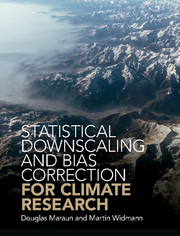Book contents
- Frontmatter
- Dedication
- Contents
- Preface
- Acknowledgements
- 1 Introduction
- Part I Background and Fundamentals
- Part II Statistical Downscaling Concepts and Methods
- 10 Structure of Statistical Downscaling Methods
- 11 Perfect Prognosis
- 12 Model Output Statistics
- 13 Weather Generators
- 14 Other Approaches
- Part III Downscaling in Practice and Outlook
- Appendix A Methods Used in This Book
- Appendix B Useful Resources
- References
- Index
12 - Model Output Statistics
from Part II - Statistical Downscaling Concepts and Methods
Published online by Cambridge University Press: 27 December 2017
- Frontmatter
- Dedication
- Contents
- Preface
- Acknowledgements
- 1 Introduction
- Part I Background and Fundamentals
- Part II Statistical Downscaling Concepts and Methods
- 10 Structure of Statistical Downscaling Methods
- 11 Perfect Prognosis
- 12 Model Output Statistics
- 13 Weather Generators
- 14 Other Approaches
- Part III Downscaling in Practice and Outlook
- Appendix A Methods Used in This Book
- Appendix B Useful Resources
- References
- Index
Summary
As discussed in Chaper 8, both GCMs and RCMs are substantially biased compared to real-world climate (Flato et al. 2013, Kotlarski et al. 2014). Impact models such as hydrological models are typically calibrated with observed input data to produce realistic output; if driven with biased climatemodel output, thesemodels in turn produce biased outcome themselves (Wilby et al. 2000). In addition, as discussed in the previous chapter, climate models – both GCMs and RCMs – often do not provide the resolution desired by impact modellers. For instance, the statistics of grid-box precipitation and station precipitation may be very different. Thus, impact modellers often demand some kind of bias correction and downscaling of climate model data. In an attempt to remove systematic biases and to bridge the scale gap between dynamical model output and the desired resolution, a wide variety of statistical bias correction methods has been developed. For reviews of bias correction methods, refer to, for example, Maraun et al. (2010b), Teutschbein and Seibert (2012) and Maraun (2016).
The idea of all these methods is to estimate some distributional properties of the climate system (e.g. long-term means, variances, quantiles) both in climate models and observations, and then infer a transfer function that maps the model property onto the observed property.
With the availability of large climate model ensembles such as those provided by CMIP (Meehl et al. 2007a, Taylor et al. 2012) or CORDEX (Giorgi et al. 2009, Giorgi and Gutowski 2016), bias correction has become very popular. Over recent years, the use of bias correction became quite standard in the production of national and global climate change projections (e.g. Maurer 2007, Li et al. 2010, Hagemann et al. 2011, Dosio et al. 2012, Stoner et al. 2013, Girvetz et al. 2013, Hempel et al. 2013, Maurer et al. 2014, CORDEX 2016). These studies have in turn served as input for impact studies (Gangopadhyay et al. 2011, Girvetz et al. 2013, Hagemann et al. 2013, Warszawski et al. 2014) and assessment reports (Cayan et al. 2013, World Bank 2013, Georgakakos et al. 2014). More and more bias corrected data has been made available through online portals by climate service providers and coordinated modelling experiments (Worldbank n.d., prepdata n.d., CORDEX 2016).
- Type
- Chapter
- Information
- Statistical Downscaling and Bias Correction for Climate Research , pp. 170 - 200Publisher: Cambridge University PressPrint publication year: 2018
- 3
- Cited by



